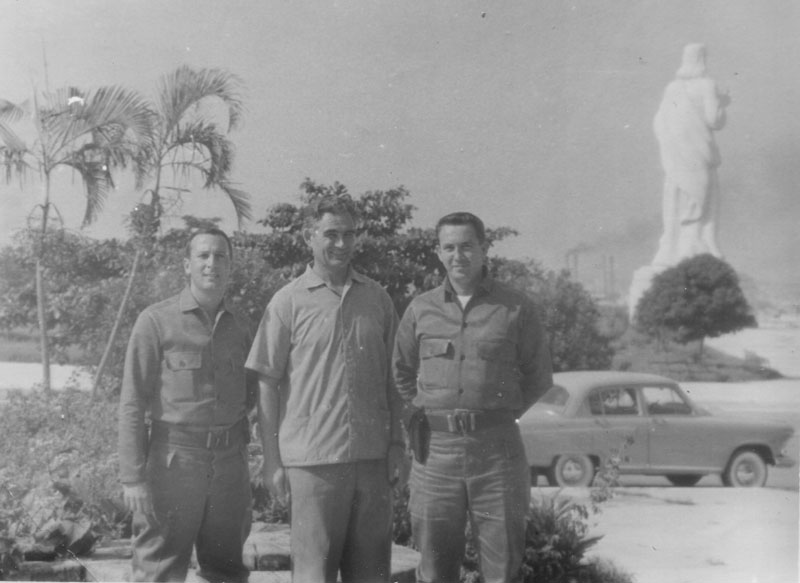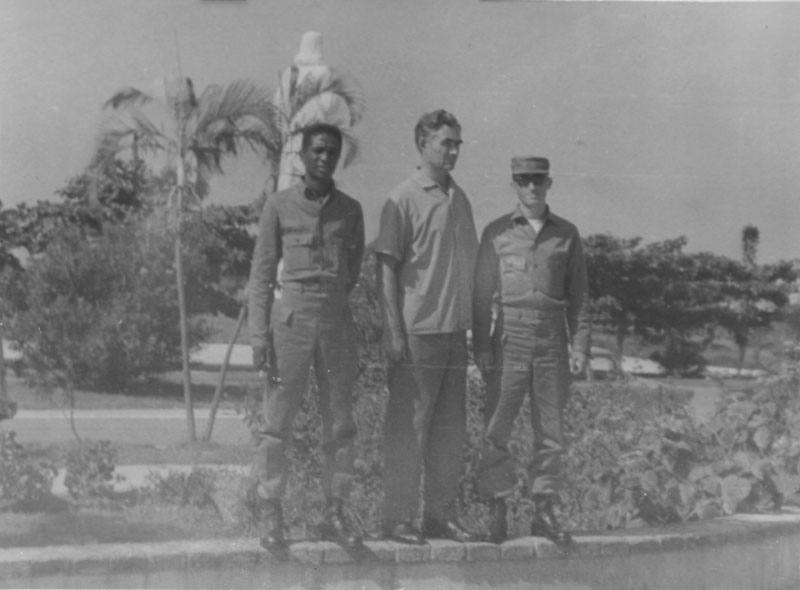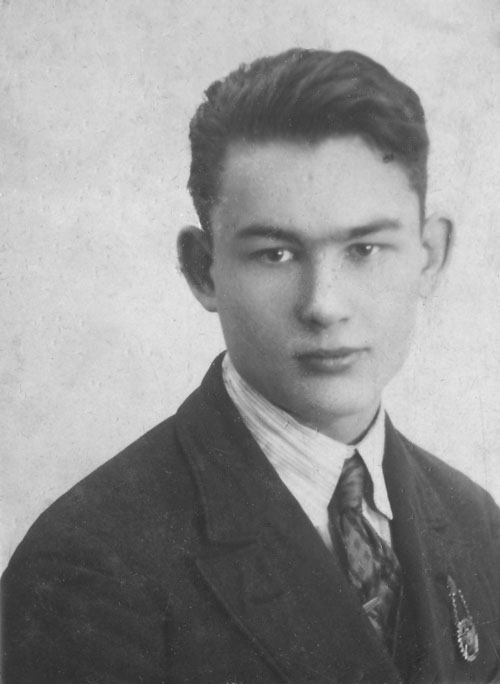
1936
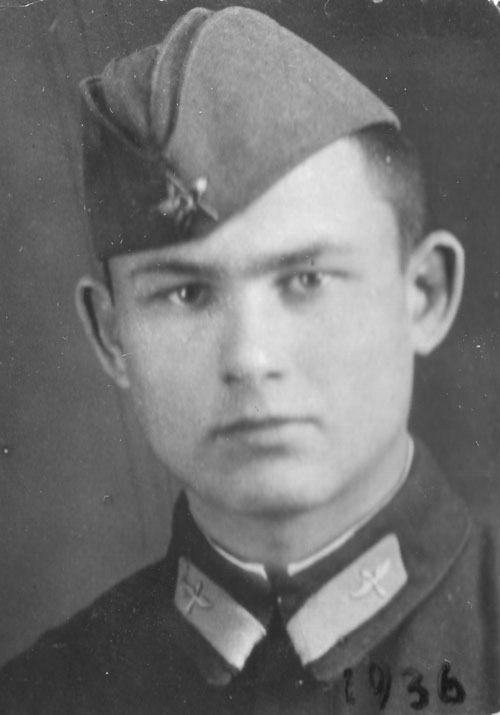
| Interview with Gunbin Nikolai Alexandrovich by Oleg Korytov and Konstantin Chirkin; Editor: Igor Zhidov; Special thanks to Svetlana Spiridonova |
| |
Gunbin Nikolai Alexandrovich:
I was born in 1918 in Yaroslavskaya oblast. My mother was a peasant, dad used
to work as a salesman in Petersburg before revolution, and after it he worked
in Sestroretsk.
I studied for 4 grades in the village, and then I moved to my father who lived
alone in Sestroretsk. There I graduated from middle school and was accepted
to Leningrad Institute of Agriculture. It used to be located at Marsovo Field,
in a three storey high building near a monument to Suvorov. I studied there
for one year, and then I was sent to aviation.
- How it happened?
In 1936 I was sent to aviation school via Komsomol...
1936 |
 |
- Did you fly before that in aero club?
No, I was sent to Navigators school in Chelyabinsk.
- You should have undergone at least two commissions? Medical and mandatory?
There were commissions, but I passed them easily.
- How many people didn’t pass?
That I do not know.
We were told to go for medical commission. I have no idea how many of us were
there. It was in Leningrad. Then we were told:
- You are fit for aviation. Now you have to go to Moscow, there you will be
joined by the other groups, from Moscow and Kiev.
When we came to Chelyabinsk, we were sent to a place named Chebarkul. There
was a camp, where cadets from Chelyabinsk Navigator school trained.
- This is where your training begun?
It is all written in my book. It was printed in 50 000 samples, you should be
able to find it. When I wrote it I had much better memory. Now everything gets
dimmer. But there is nothing I can do – I’m 90 years old.
- When you arrived to school, you had a “young soldiers course”,
then “terka” had begun?
Oath, then “terka”.
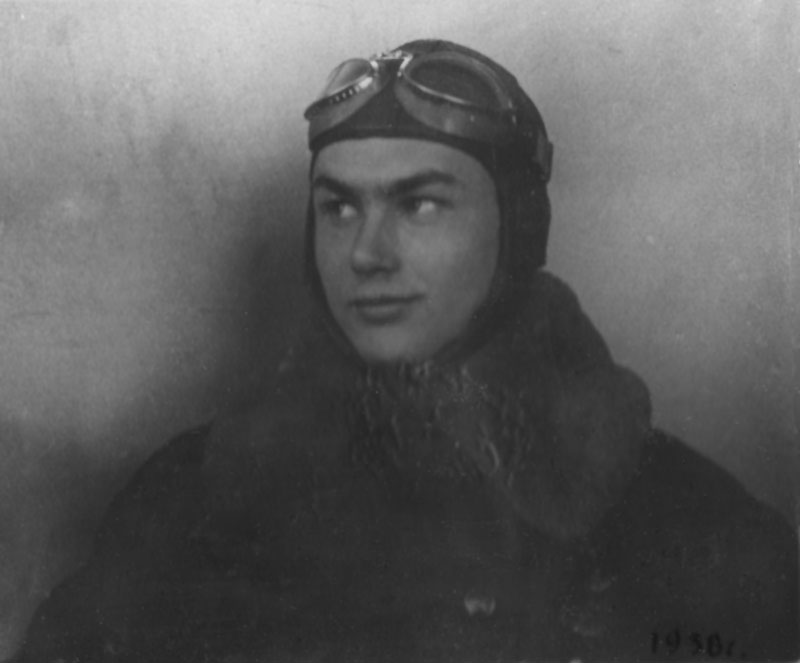 1938
1938
- When and which plane you begun flying?
We began flying after a year, from our arrival. At U-2, TB-1 and TB-3. Then
more modern airplanes appeared. SB, for example.
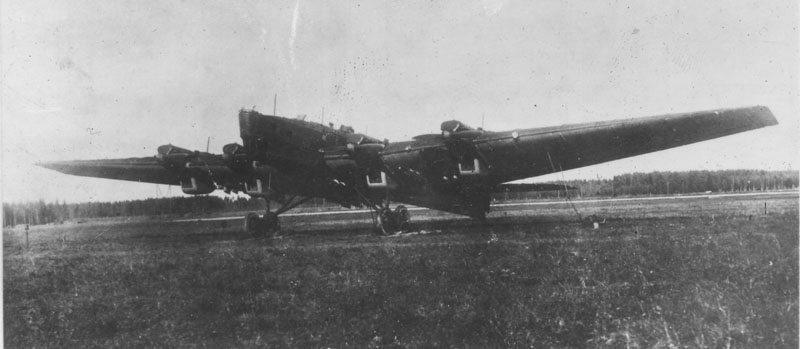 TB-3
TB-3
- You were a sole navigator on board of TB-1 and TB-3 while training? Or you
were packed in like sardines in a can?
Usually we were given a point where we should guide our pilots to. On the ground
we plotted the course. Then we climbed to navigators’ cabin And gave directions
to the pilots where to fly. There also was an instructor there.
- Instructor trained only you in these flights, or others were also there?
Several cadets.
- Where they were waiting?
There were seats in the fuselage. In TB-1 there was little space, while in TB-3
ten cadets could be easily seated.
We set course on the ground, and then changed in flight to guide pilots.
- Were there cases of lost orientation?
Of course, we couldn’t have studied without them. There were cases. But
we managed to correct our selves anyway.
- When you graduate from the school?
In the summer 1939.
 |
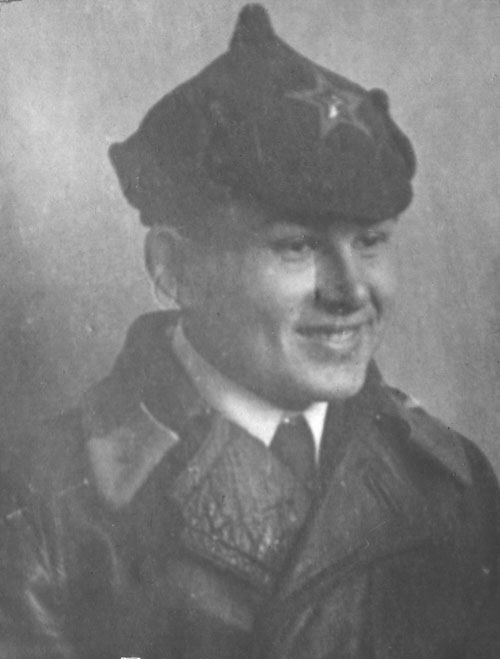 |
| Cadet Gunbin in Chelyabinsk 09/09/1939 | 9.9.1939 |
- What kind of exams you had to pass?
There were special disciplines at which we had to pass exams. Bombing, navigation
and radio.

- Did you practice bombing at shooting range?
Of course. We had special cement practical bombs.
- Was it filled with colored dust?
No, there was no such dust in our bombs.
- How then you could see where they hit.
Smoke was going out of them... Usually black. There were no special paints.
- Where you were sent after graduation?
To Khabarovsk. I forgot the regiment number. We can take a look in a book.
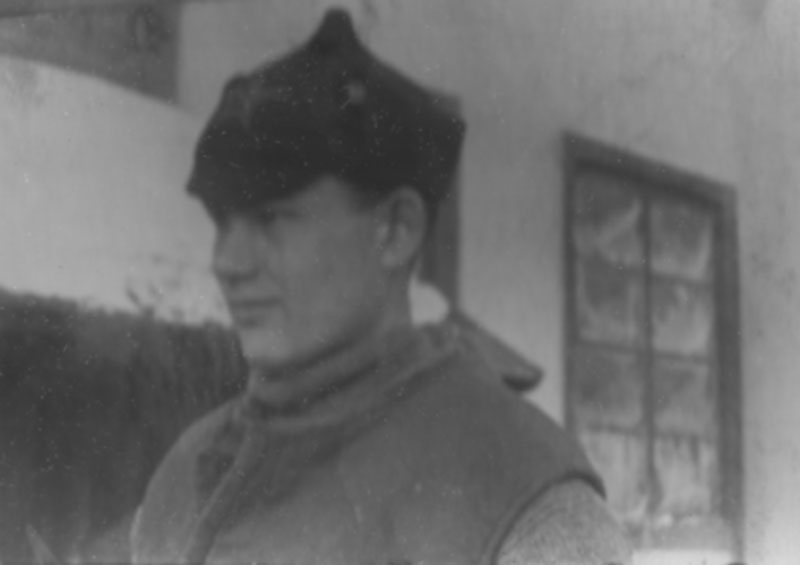 Khabarovsk 1940
Khabarovsk 1940
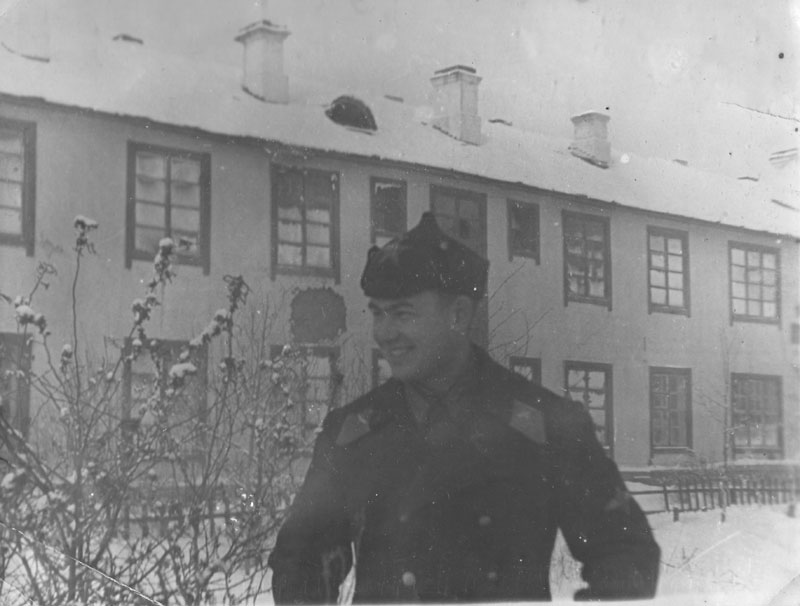
- What type of airplanes?
DB-3a. Annushka. Navigator sat in front cabin, pilot in the middle, and one
gunner in the rear.
- Did you study DB-3 in the school?
No.
- You came to the regiment with new equipment. How you were met there?
At first we were told to which crew we were assigned, then crew was assigned
to an airplane. I came to my pilot and said:
- I’m appointed as a navigator in your crew.
Pilot Ivan Evseev replied:
- Very nice to meet you, let’s fly together.
So we flew together on this DB-3A. Then it was announced that I was picked to
be sent to Ivanovo to special navigators’ school. So I moved there right
before war begun.
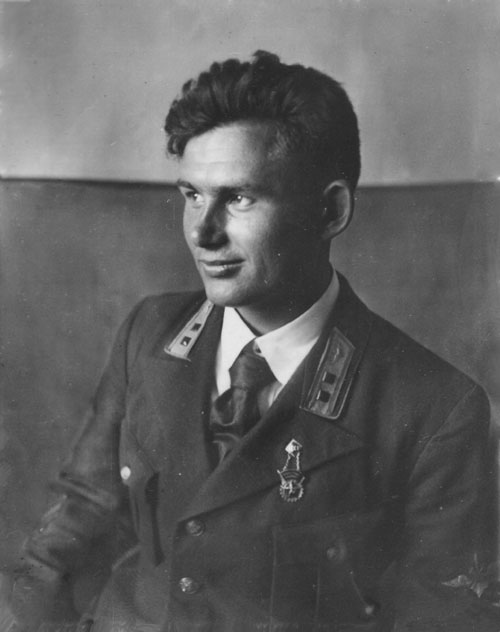 Khabarovsk 1940
Khabarovsk 1940
- Were there veterans of Spanish, Finnish, or Japanese wars?
I believe there were several veterans of Spanish campaign. There were meetings,
where they told us what we should do in which cases, to avoid mistakes... They
passed us their combat experience.
- When war begun, were these stories of any help to you? Or information
was out of date?
Of course! Basing on their mistakes and achievements we accomplished our missions.
- When you begun flying DB-3, it took you long time to get used to it?
I was already prepared to fly as navigator.
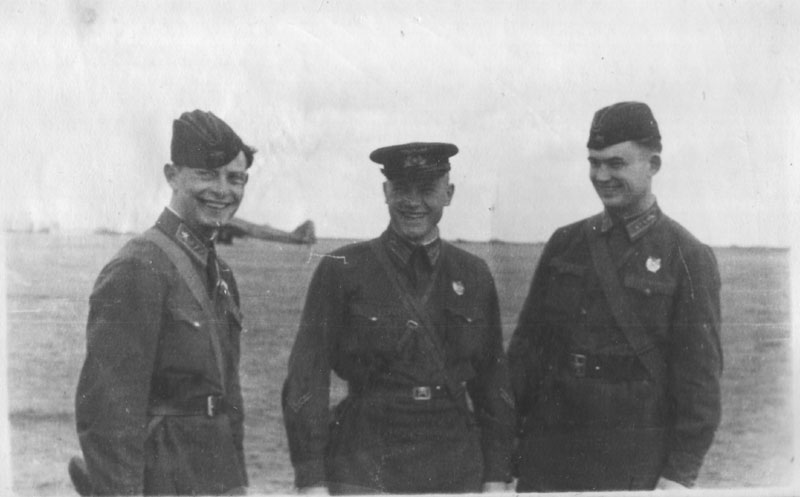
Senator, Parashenko, Gunbin 1942 Lipezk
- Did you pilot a DB-3? You should have had a stick and pedals...
You seem to know everything! And really, pilot sometimes asked:
- Nikolai, please, fly the plane.
I took handle and piloted an airplane...
- Pilots, who flew DB-3F said that it was very easy on controls, but that
it also was very unstable, demanding constant controls input. But due to long
range of this bomber it was exhausting. Is it true?
You mean, when we helped pilot to fly the airplane?
Yes, we did. For example, when one of the engines failed. We had two, and pilot
had to push one foot to compensate for gyroscopic force. He would say then:
- Nikolay, put the stick in, and help me.
And we flew together.
- Were there cases when navigator would land a DB-3?
Yes, but I can’t recall who it was exactly.
- You were sent from Far East to Ivanovo navigator school... To which position?
A cadet of this school.
- Why cadet? By this time you graduated from navigator school?
Firstly, planes were different by this time. Secondly, Finnish war just ended,
and we studied its experience...
- Something like raising your qualification?
It was called Supreme navigator school. Chief of this school was Ivan Timofeevich
Spirin.
- How you found out about war start?
Alarm was sounded, and on line up we were told that Germans had crossed the
border.
We were sent to Oboyan... It’s a town near Kursk. Between Kursk and Belgorod.
On 23 June we were loaded into train cart and were sent to the south. On 22nd
war begun, 23rd we were loaded; on 27th we flew our first mission.
- Do you remember regiment number?
220th regiment, if I remember correctly?
- Who was your pilot?
My pilot on DB-3 was Kharchenko Stepan Andreevich.
- What kind of an airplane it was - "stub" or "cigar"?
Pointed nose already "DB-3F", I think.
- Which one was more comfortable for you as navigator, "Annushka”
or "cigar"?
"Cigar". View was much better.
- When combat missions begun, you must have flown day missions at first?
Yes.
- When you begun understanding what was going on the ground and in the air?
We studied the Spanish War experience, thus we already had understanding of
what was going on.
- In first missions you bombed by yourself, or by leader?
At first we flew in nine plane formations. When leader dropped his load, we
also pressed the button. By leader, that is.
- You actually saw where you dropped bombs? Or you looked at the leader
only?
We saw everything. We looked after bombs and ground. We saw everything.
- Who caused you more losses? AAA or fighters?
We suffered more losses to Messerschmitts.
- At which altitudes you usually flew?
Approximately 3-4 000 meters. But when we flew solo, we flew at low altitude.
- When you begun flying solo missions?
It was later, when we suffered losses. When we begun flying night missions,
we flew solo only.
- How your regiment was organized in the beginning?
Three squadrons, nine planes in each.
- Three, not five?
Yes, at first there were five squadrons, and then there were three. May be regiment
was divided in two, or maybe due to losses?... I don’t know why commanders
decided so.
- How many missions you flew on one airplane?
In 1941 I accomplished 20-30 missions. Then regiment was sent to restructure...
There were losses, of course... I wrote it in the book. Read it. Now my memory
starts to fail me.
- In the autumn your regiment was pulled out of active duty. How many crews
stayed from those, who met war?
I don’t know. We were transferred to 98th regiment, and begun flying DB-3F
again.
Up: Gunbin in may 1942 Right: Gunbin in Monino, july 1942 |
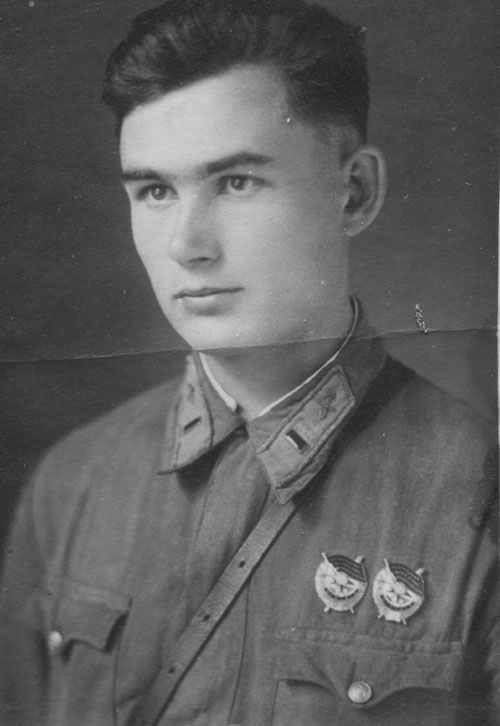 |
- Now you were flying at night?
In 1942 we flew only at night.
- By your experience, what was the main deficiency of DB-3?
The main... On takeoff it had strong tendency to turn to the right. That was
its problem.
- When war begun, what was the crew in DB-3?
Crew: Pilot, navigator, gunner-radio operator, gunner. Two gunners.
- Was defensive armament sufficient?
It was. I wrote in a book how in one mission three Messerschmitt-109s were shot
down.
- Not by one crew?
By one.
- Whose crew it was?
Our crew. Crew of pilot Kharchenko. I don’t remember gunners names now.
- How much punishment could Il-4 take?
At first fighter attacks were very dangerous, but later self-sealing tanks were
introduced. If a bullet pierced a tank, it would seal off the hole, or reduce
fuel leak to drops...
- Could Il-4 have reached home on one engine?
With difficulties. On one engine it could reach home base only if pilot was
good. Some were unable to fly it in such configuration, so they had to land
on airfields closer to frontline.
- You were in Long range aviation. Your chief was Golovanov. Could you say
what you think of him?
Golovanov was an excellent commander; he flew to our regiment, talked to us,
asked what we thought. I should have a photo in my book where he talks to us.
Golovanov was a good commander.
- When ADD was reformed into 18th Air Army, did it mean any changes for
you?
It didn’t touch us in any way. It was commanders’ matter...
- How many missions you flew per night?
No more than two. Two we flew when targets were close by.
- What was your farthest target?
Most distant target was Berlin...
- Where you flew from?
We flew from an Oboyan airbase. We filled all tanks and adjusted drop tanks.
We used fuel from drop tanks first, then we jettisoned them like bombs and flew
on.
- What was the bomb load in those missions?
If without drop tanks – 10 FAB-100 in bomb bays, and 2-3 FAB-250 on external
bomb racks. Or one FAB-500.
- You bombed any specified objects in Berlin, or just the city?
Usually we bombed railway stations or city center, where there were German stabs.
- Did you bomb with RRABs?
Of course.
- I read that pilots didn’t like RRABs because it was not “clean”
aerodynamically…
Yes, yes. It was called a "barrel". Because of it we lost speed and
range. That’s why we didn’t like them. But if we speak of effectiveness
it was great. RRAB was effective weapon, because it held many bombs inside,
and covered great area. But in terms of piloting it did have drawbacks.
- Which bomb types you used?
Main was FAB-100 and FAB-250. FAB-1000 we carried rarely, against special targets.
There were solitary flights with FAB-1000.
- What was the heaviest bomb load for DB-3?
1 500 kilograms.
- When you flew your first mission against Berlin?
In summer 1942.
- What were your main targets in 1941?
Daytime missions in 1941 were against advancing tanks and river crossings, where
troop traffic jammed...
At night we bombed railway junctions.
- How results of bombing were accounted for?
Firstly, by report:
- I saw explosions, something caught fire, saw secondary explosions.
Secondly, photographs. Results were documented by photographs.
There were special controllers, who flew in the last plane of the formation
and looked if target was destroyed or not.
- Were there special crews that illuminated the target? Or they appeared
later?
When we begun to bomb at night, we usually dropped bombs at illuminated targets.
Specially picked crews were given this task.
- Did you fly this type of missions?
Of course. My friend Vasilii Senko, the only twice HSU – navigator also
flew them. A Tu-160 named after him recently flew to Venezuela.
- What was the illuminators job?
Only best crews were assigned this task, they had to fly first, locate
the target, and hang SABs over it. Other crews bombed lit target...
Sometimes I also had to be an illuminator.
- You were a flight or squadron navigator then?
Flight navigator. Later I became a Deputy Regiment navigator...
- Who was assigned to be a photographer?
Not the worst crew either. But illuminator had more important task – to
find and designate target. All the rest were less important.
- Lets imagine, that regiment hit the target... But photo crew was shot
down. How the results were confirmed in this case? Second one is sent out?
Hard to say. In each case it was different. There were partisans too, who could
say where we hit and what happened there.
- What if illuminator got lost and hanged SABs at the wrong place, will
you bomb illuminated area, or will you go searching after darkened target?
At the main target, of course. If some field is illuminated, what’s the
reason for me to waste ammo? I’ll go and search for target myself.
- You were given a task of bombing some object. You were also given a route
or you calculated it yourself?
It depended on many things. But, we usually were given route and altitudes.
We were given a task, with pre-defined altitudes. This allowed us to avoid collisions.
- What was bomb release altitude at night?
At night it was 2 000-5 000 meters.
- Who gave you the order?
We received tasks from regiment commander. I remember Kichin and Ivan Karpovich
Brovkov.
- What about Petushkov?
Petushkov was in the end of war. Two men should give an order: regiment commander
and regiment navigator. Commander gives order in general, navigator points out
on a map what was going on more precisely.
- Where they received an order from?
Division commander, for example. I haven’t worked in high-rank stabs at
war time. We didn’t care who gave the order. From division, that was enough.
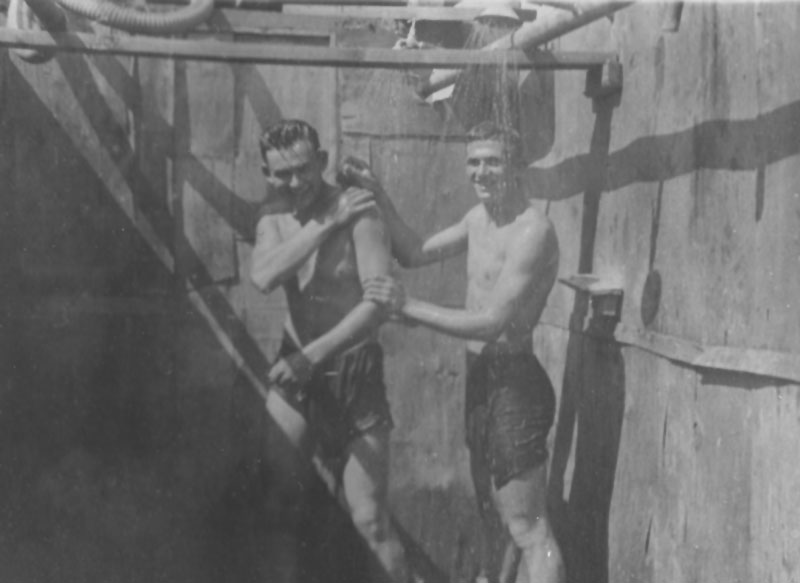
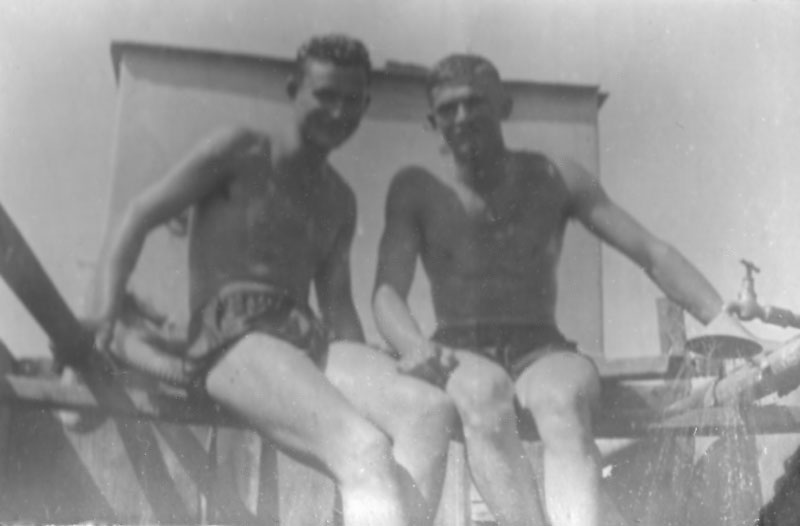
- You lived an owls life. Work at night, rest at day, when you returned
home?
On average at four or five o’clock in the morning.
- What you did then?
We received a coupon for 100 grams, breakfast, and slept till new order comes
in. Let’s say, till 00.00 or 02.00...
- At about 06.00 you had breakfast?
Yes, and went to sleep.
- And then?
Then we received a new task and flew to accomplish it. In 1943 we were based
near Andriapol. On the other side of the river was a village, where there were
dances. That was what we did for fun.
- 100 grams was enough, or you needed extra?
It was enough. Sometimes we had some extra in a flask, but just in case...
- No way a war can be fought without losses. How you dealt with them?
We began to worry if crew didn’t appear after two or three days. Quite
often airplanes landed at other bases with damage... If he sent us a message,
we knew where he was and what happened. If there was no notification in a few
days it meant that crew was lost. Of course it was a heavy burden and we were
sorry for them...
- What you did to the belongings of the perished?
Adjutant was responsible for that.
- In 1941, when Germans were racing towards Moscow... Did you suffer from
low morale?
It was a hard time. But morale was still high, and we still bombed the enemy.
Our regiment had a name Stalingrad, because we bombed Germans there all the
time they were in Stalingrad.
- Which capitals you bombed, apart Berlin?
We also bombed Warsaw. And Budapest. In Romania we also bombed Konstanza port.
- In Budapest and Warsaw you bombed city in general, or some specific target?
We were given railway stations as targets. Not some precise buildings. We couldn’t
have seen it at night.
In Konstanza we bombed the port itself. It was difficult to locate warehouses
at night.
- For how many missions you received awards?
We were not interested in this. Who received which award? Only when HSU was
issued to someone everybody was happy.
- For which amount of missions flown you were awarded with an HSU?
Who knows? I wasn’t interested. I flew 298 missions against distant targets.
Not only quality of missions was accounted for, but distance and importance
too...
- How many missions you flew against Helsinki?
I flew only one or two missions against it. Against Finland I flew maybe five.
Can’t remember exactly now, we bombed towns at the shore, Kotka, Turku,
Abe. We were damaged there once quite severely, I even suggested to land in
Levashovo near Leningrad. But then we discussed this matter, and decided to
try and make it to home base, because Leningrad was surrounded. We didn’t
make it to our home base, but landed on another airfield much closer to ours.
- We talked a few hours ago with Dudakov; he said that targets in Helsinki
were given in such way that no civilians would suffer. Did you receive such
order?
Yes. We were tasked with bombing railway station and port. We were directly
prohibited to bomb civilian sector.
- Finns claim that when raids against Finland were going on in 1944 they
managed to shoot down a lot of our bombers. Do you remember such heavy losses
in your regiment?
When we flew against Finland losses were very light, if not altogether absent.
- On 7th or 8th August heavy losses were caused by mist. Were there cases
of lost orientation and crashes?
There were such cases. But they didn’t cause a lot of life loss.
- If not count 1941, when your regiment suffered heaviest losses?
Worst losses were in 1941, of course, when sometimes half of the planes didn’t
return from a mission. In 1942, 1943 and 1944 one or two planes didn’t
make it to home base each mission.
- When you started to feel the presence of night fighters?
When we started flying night missions, Germans began applying night fighters.
- Did your gunners drop aluminum foil?
Foil? Yes, but it was used against AAA. Don’t remember when it first appeared.
- Bombs have different ballistic qualities. How you aimed, keeping in mind
that you had FAB-100, FAB-250 and FAB-50 loaded in your plane?
Heavy bombs were hanged outside of the fuselage, and we made calculations by
these bombs ballistics.
- How many passes you made?
Depends on target. No more than two. We usually bombed from one pass. If there
was a predicted need to make adjustments, we could drop one bomb, and then the
rest of the load on the second pass with all corrections made.
- How precisely navigator could have placed a bomb load from an altitude
of, say, 5 000 meters?
If a pilot is good, holds course and speed well, good navigator could put bombs
from first run in a 20 meter radius.
- You dropped bombs all at once or in series?
Usually, in a series... Along, across, depending on target.
- Which type of targets was most difficult to locate?
Troops concentration. Railway junctions or airfields were easily located.
- You took off to bomb airfield. Airfield has one runway – two kilometers,
second runway – two kilometers; airplanes are spread over whole territory
or even pulled out beyond airfield boundaries. I doubt that it is possible to
find a camouflaged airplane at night from an altitude of four kilometers.
There were illuminator crews. Some crews had a task of bombing runways. But
main target were airplanes, parking areas along runways... Airplanes were not
too far away, usually at the borders of airfield.
- Did you receive to bomb airfield by a part of the bombers, while others
would bomb nearby village, where crews might live?
No, we didn’t bomb crews, only planes.
- What was considered to be a destroyed airplane?
If it caught fire it was thought of as destroyed. It was difficult to establish
degree of damage from altitude, but if it was on fire – it was definitely
destroyed.
- When you destroyed airplanes on the ground, were you paid for destroyed
aircraft?
No, we were not paid.
- Did you work against ships?
Yes, usually in a port, like in Crimea.
- Relationship between flying crew and technical crew?
Very respectful towards each other. And ground crew was happy when we returned
from a mission...
Flight crew thanked technicians that engines didn’t fail and no other
problem appeared.
- Weren’t there such attitude that we are flying while it is unclear
what you do in meanwhile?
No. We liked them a lot.
It was not just friendship in our crew, it was something more... In august 1944
I received an HSU, and commanders suggested me to go to Monino Academy to raise
my level of expertise. I refused. I couldn’t have abandoned my regiment,
my pilot Stepan Kharchenko. I said that I will apply for the place in the academy
after war ended. We were so close that there was no need to say anything; we
even had a common intuition. It wasn’t friendship; it was something more
complex...
- Did you fly with other pilots?
I did. For different reasons, if a pilot was sick, for example. And my pilot
sometimes had to fly with other navigators.
- Do you remember your airplanes tactical number, and how it was painted?
Numbers were different, on the fuselage and fin. Planes were painted in green
with some camouflage over it.
- And from below?
Gray, if I remember correctly.
- Were there paintings or insignias on your bomber sides?
No. What for?
- Were there gifted planes?
There were. Commonly, from eastern cities. Which ones – I cannot remember
now
- Did you use KS ampoules?
No, but there always were small ZABs in RRABs.
- Did you use RSs?
Never.
- Did you use AG system?
There were no such devices on our machines. Just machine guns.
- You said that your crew shot down three Messerschmitts in one mission?
Yes. When we flew day missions in 1941. Our gunners saw approaching fighters
and shot them down, while Germans tried to shoot us down too. That time fascists
pressed their attacks too bluntly, and came too close, so they got what they
were asking for...
- Did you draw stars on the fuselage to commemorate victories?
No, that was fighter pilots prerogative.
- Did gunners receive money for downing enemy fighters?
No.
- When your regiment became Guards, did you receive Guards status along?
Everybody immediately became Guardsmen. If regiment received Guards, we also
received it.
- What if newcomer arrived to the regiment?
Everybody was immediately made guards, and a symbol was handed out.
- Were there cases if somebody would not fly combat missions on purpose?
There were no such cases.
- How about flying not to the target area, but where AA fire was less dense?
That could have happened...
- You flew long range bomber, was weather a problem for you? There was no
way to know what was going on in a few hours of flight behind frontline. Will
there be a cloud layer or a thunderstorm…
We didn’t fly through the thunderstorms, we tried to avoid it. We went
over, under it, from the sides. But not through the clouds, because it meant
that we are already destroyed.
- If the thunderstorm was wide, you returned home?
Then we flew “box”, gained altitude and jumped over it.
- That is, you never returned with a not complete mission?
No, such things never happened.
- You arrived to the target area, it is covered by clouds. You went to the
secondary target?
Of course to the secondary.
- There was one or two secondary target?
Usually one. But there always was one.
- What have you done if both targets were covered by clouds...?
Both targets covered? We bombed by time calculation.
- Could crew navigator demand to change bomb set on his plane?
I don’t remember if such things happened. What was ordered from above
was hanged on the planes.
- Aiming devices improved with time, or you kept flying with OPB-1 till
the end of war?
OPB-1 was in the beginning of the war. Then aviation-collimator sights were
installed in the front of the cabin, we used it day and night, it allowed navigator
to see what was going on around. Where shot from, how to maneuver. This sight
was much more comfortable to use.
- Orders from navigator to pilot were given by voice or by some sort of
electric signalization?
What for, we had an intercom.
- Was there a pneumatic mail in the plane?
Yes. It was used as a secondary way to connect with gunners.
- Problem appeared, airplane is damaged, and you have to abandon it. How
it was done?
Pilot, as a crew commander, gave an order to abandon ship when he felt that
it was not airworthy anymore.
- You had a hatch under your feet. You jumped there?
Yes. Gunners also had a hatch. Pilot had to fall over cabin side, to the wing
and then slip down.
- How many times you were shot down? We know of two cases. But how many
times in all?
I never counted, but at least several times we were shot down. But usually we
managed to cross the frontline, locate some airfield and land there?
- Did you use parachutes?
Two times I bailed out with a parachute. When I was shot down first time, I
landed on my knees. We thought then that my knees were damaged. In a hospital
I received some help, and was allowed to fly further. But then it was diagnosed
that I had damaged vertebra and hips. Second time I was shot down in that same
1943. After falling I crushed all thorax. Ribs later healed, but I had two hernias
at the esophagus and diaphragm... But I felt good up until the age of 85, drove
a car for 1 000 kilometers.
But for last four years I feel sick...
- From which altitude you still could bail out, from which you had to land
only?
If there was a possibility to belly land, you have to land from any altitude.
But if there was a need to bail out it should have been done from an altitude
of over 500 meters.
- You flew at high altitudes. Did you use oxygen?
We used it from about 4 000 meters. To be sure that it will be enough we used
it economically.
- That is, it was not enough oxygen for a full range flight?
Well, you can’t really say that. We descended on the way back, and then
we switched oxygen devices off.
- Did you use your machine gun?
Yes. Against ground targets.
- Weren’t you punished for it? Isn’t it a direct threat to your
own airplane?
It was not a matter of punishment. If we descended and strafed ground targets
with machine gun fire it was only welcome.
- Your colleague told us that he flew to drop saboteurs and intelligence
agents. Did you fly such missions?
No. We were bombers, and only bombed. No such missions were given to us. Only
bombing.
- When you flew your last combat mission?
In the end of war. I do not remember the date now; it should be in a log book.
- How you found out that war ended?
I was in a hospital at that time; I had some problems with my stomach...
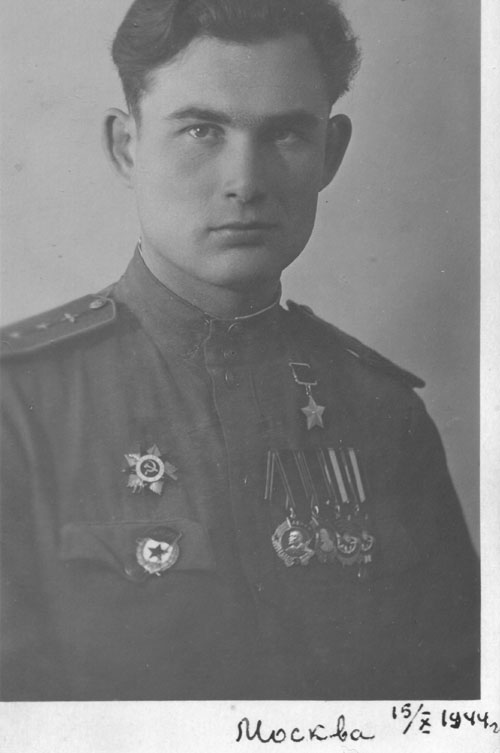 |
With the wife in 1945, Moscow |
- When you crossed a border of the Soviet Union, how local population reacted?
We were very welcome... Civilian Poles and Germans liked us.
- Did you go on trophy raids?
I don’t remember such cases.
- Your personal attitude towards Communist Party and Stalin? Not nowadays,
but at that time?
We were members of communist party, and we fully respected all actions of Central
committee and Stalin.
- Were there Special Department agents in your regiment?
Yes, there was a special department.
- What was it’s responsibility?
It was there to be sure that no one is passing secret data to the enemy...
- In your opinion, was there a need of Special Department in your regiment?
I believe that our regiment could have lived without it. We all were loyal to
our party, and if someone would have opposed, we would have wasted him ourselves...
- Political officers were flying?
There were those who flew, and those who didn’t...
- When you received an HSU, how you found out about it?
An order came to our regiment about me and several others. We were called to
Moscow. Award was handed out by Mikhail Ivanovich Kalinin. There were 33 Heroes
in our regiment.
- Out of 33 Heroes, how many made it through the war?
Can’t really say. A half, maybe...
Not all were killed in combat. Vasilii Senator was killed in a weapon mishandling
accident. One navigator pressed a trigger by accident...
He was a good guy, Senator Vasilii...
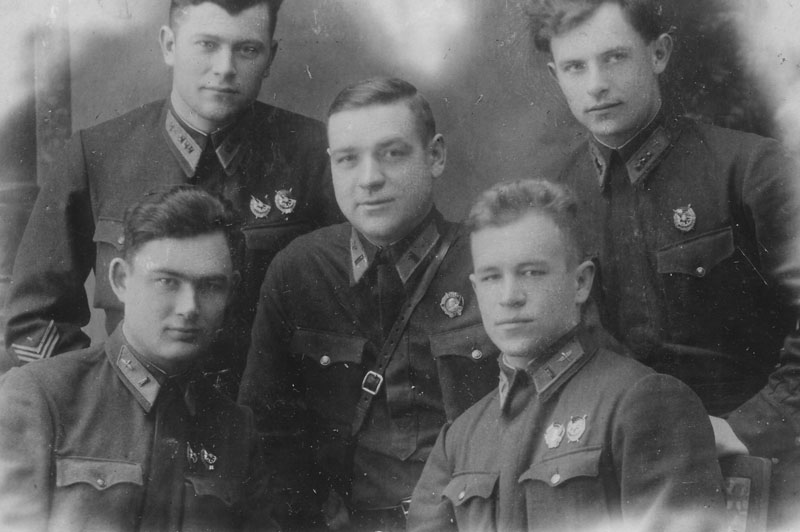
November 1942, Kirsanov. 1st row Gunbin, Glushenko, Grosul 2nd row Parashenko, Senator
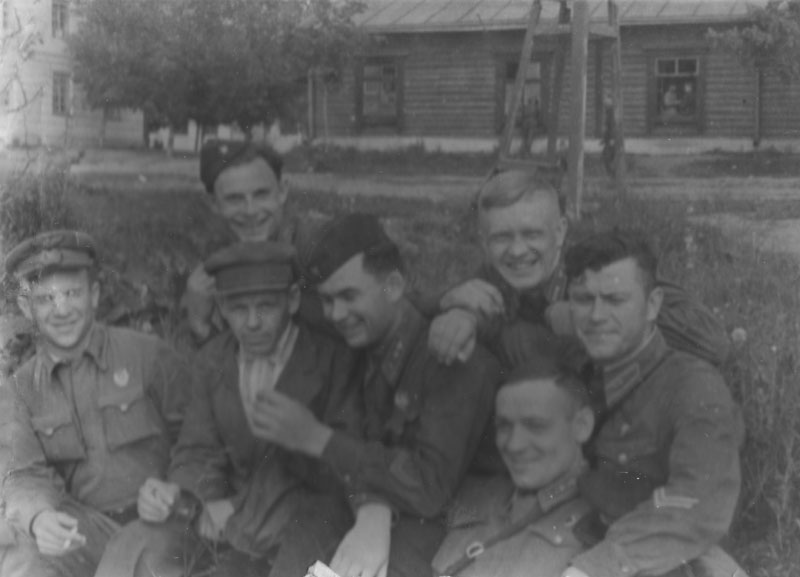
Grosul, Senator, Gunbin, Glushenko, Parashenko, higher Petelin
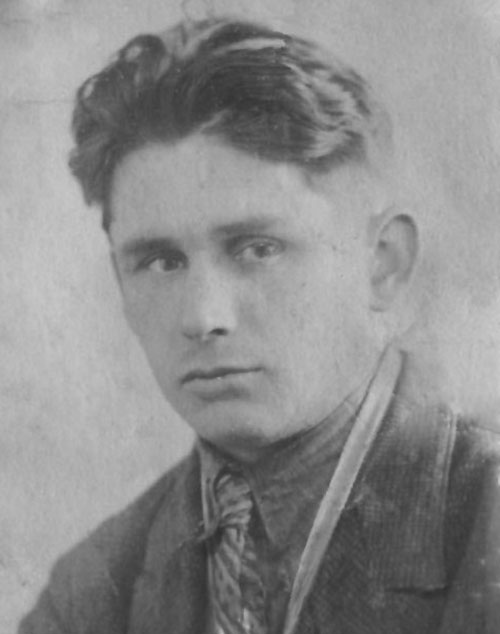
 Gunbin in Cuba, 1968
Gunbin in Cuba, 1968
